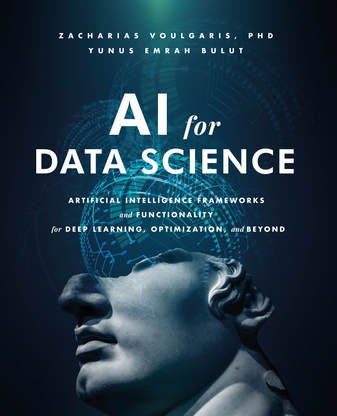|
Interestingly, the video throughput on Safari has increased lately so we don't have to wait too long before a video gets approved and published. This little guy, for example, I just finished on Thursday and it's already online at the Safari platform. It's by no means an exhaustive survey of the ML field, which is much larger than many people think and it doesn't include A.I. methods only. This video is more of an overview of ML and how it relates to other aspects of Data Science, such as Statistics, A.I., and various applications. So, if you are new to Data Science or want to get a comprehensive overview of the topic to supplement your studies of the subject, feel free to check it out! Recently an associate of mine and I have started a blog on Medium, focusing on A.I. related topics. There are no articles on it at the moment, but we are actively looking for potential authors of such articles. Every author can have a short bio of him/her and a link to their site of choice (e.g. their company’s site, their own blog, or even an online professional profile of his/hers). Right now, we don’t have very restrictive requirements regarding the articles, so anything that is related to A.I. (especially its applications and its real-world impact on fields like data science or robotics) qualifies. Also, there is no word restriction so if you want to write a whole mini-book on this blog, you can be our guest! If you are interested, feel free to let us know either through the comments below, or via a direct email to me (you can use the contact form at the corresponding page of the Foxy Data Science site). Cheers! So, about 18 months ago I created a video on Safari about how A.I. could benefit Data Science (DS and AI). Even though at that time I was still figuring things out regarding how educational videos work, the vid was immensely popular and even today still attracts lots of views. Considering that all of my recent videos are (much) better than that one, at least technically, this is quite intriguing. Anyway, fast forward to September last year. As I was walking in the streets of suburban Seattle, thinking about what to do next (my Data Science Mindset, Methodologies, and Misconceptions book had just been released), I decided to write another book, one about A.I. since this topic continued to fascinate me, while it was becoming a popular topic among various data scientists. So, I pitched the idea of a new book to Steve Hoberman and after sorting out the details, we got a contract going. However, due to various reasons we decided to start the book in January. The whole project was quite a turbulent one, with my co-author dropping out around March, leaving me in a very difficult situation. Yet, I decided that the book was worth completing. Fortunately, another data scientist / A.I. expert decided to join me in this endeavor, Yunus E. Bulut, who I got acquainted with through Thinkful. Long story short, after a few discussions about the project he had a contract of his own as a co-author. Three months later, the first draft was complete. Of course the book went through a lot of revisions since then, partly because the technology was changing and partly because there were a lot of topics in this book, which was difficult to coordinate and merge into a coherent whole. Also, at one point Julia reached adulthood as a programming language (v. 1.0) so we had to update the code for the chapters that had programs in Julia. So, after a feverish summer, plagued by heat waves and other obstacles, we finished the edits (at least the most important ones, since a book is never really finished!) and the book went to the press. Now, it is finally available for you to buy at whatever vendor you prefer. Check out the publisher's site for more details. Cheers! With all the plethora of material out there for data science education, it is easy to get overwhelmed and even confused about what to study and how much time, money, and effort to put into it. Enter evaluation of data science material, a concise strategy for tackling this issue. In this 24 minute video, I talk about the various aspects of data science material, criteria for evaluating it, the matter of resources required to delve into this material, and some useful things to have in mind in your data science education efforts. Whether you are a newcomer to the field or a more seasoned data scientist, you have something to learn about data science (I know I do!) and this video can hopefully aid you in that. You can find it on Safari. Note that in order to be able to view this video in its entirety, you'll need a subscription for the Safari platform. Also, it's important to remember that this video can offer you a framework for evaluating the data science material; you'll still need to find that material though and put the effort to study it, in order to make the most of it. The video can only help you organize your efforts more efficiently. Enjoy! Recently I read about some “research project” that Google’s A.I. branch conducted on the behavior of AIs as they tackle a certain simple scenario (a game of sorts). Various AIs were tested, including some more advanced ones, and the conclusion these researchers jumped to was that advanced AIs tend to be aggressive. Let’s assume for a moment that this was a scientifically valid research experiment and that the people involved followed science protocols closely. I know this is a big assumption but bear with me for a while. Can we accurately deduce the aggressiveness of an AI using this kind of setting? Or is there some inherent bias in the research question asked to start with? It’s important to note that the problem the AIs were tested on involved picking apples from an orchard and that the objective was to pick as many apples as possible. Naturally, there was a finite amount of apples to start with though in the beginning the orchard appeared abundant. Also, there were two AIs tested at a time and they were equipped with lasers, capable of stopping the other player for a while, so that more apples could be picked. So, after the AIs were deployed they went about their apple-picking endeavors. They took all the cash they could gather and politely lined up at an Apple store, all while contemplating what products to buy. Sorry, wrong experiment! In Google’s experiment the apples were actual fruits, not related to the tech giant who brought us the iPhone! Anyway, the AIs were given the option to collaborate or adopt an adversarial strategy (i.e. be trigger-happy when it comes to its laser pistol). Naturally they chose the latter, particularly when the number of apples was waning. The more advanced AIs adopted this course of action even sooner, probably because they could “see” further ahead. So, based on this experiment, one can conclude that an AI is bound to be more aggressive, in order to accomplish its objective, much like an animal would (e.g. a dog that feels that its territory is being threatened by some other dog that decided to pee there for some reason). In other words, intelligence can advance all it wants, but at the end of the day, its bearer is bound to act like an animal, since it only cares about winning its game (i.e. optimizing its objective function). This is sound reasonable, right? Well no. This is a particular case where an AI is given only two options and a very rigid objective, while its perception is limited to the two dimensional data of the game and a score. So, one could argue that the whole scenario is oversimplified and unrealistic. Plus what would the AI do with all these apples? Does it account for the fact that some of them may go bad or that if it decides to sell them in some form (e.g. an apple pie), there is the law of diminishing returns in the ROI of this whole endeavor? What about AI politics? What would other AIs think if it exhibits such aggressive behavior? Would anyone ever want to collaborate with it for another project? Naturally, the AIs involved in Google’s experiment don’t think about these things (like a human would probably do), since they have a one-track mind, caring only about the number of apples they collect. In such a scenario, no matter how advanced the AI is, it’s bound to seek actions that optimize the corresponding objective function, attacking anything that comes in its way, much like a short-sighted beast. Perhaps instead of taking the word of some “expert” as gospel, it would be more fruitful for someone to ponder on this matter himself. Also, if so inclined, one can build her own AI experiments and explore other alternatives in the AIs’ pursuit of apples (or some other measurable objective). After all, things are not so simple when it comes to AI, so it makes sense to examine this matter with sufficient depth of thought, unless of course we just opt for some sensational result to drive home a point, which may or may not bear any scientific validity. Business Aspect of A.I. in Data Science and Extreme Learning Machines Videos Online on Safari9/13/2018
So, recently I decided to make a couple of videos on niche topics, namely the Business Aspect of A.I. in Data Science and Extreme Learning Machines (ELMs). These vids are now available on Safari (here and here). Enjoy! Note that in order to view these vids in their entirety you'll need a subscription to the platform. The latter enables you to view other materials, including a large variety of technical books as well as all my other videos. Cheers! Last week I’ve finished my part of the final corrections stage of the new technical book I’d been working on for the past few months. My co-author, Yunus, has done the same, so the book should be in the press later this month! Hopefully, you should be able to purchase it soon, either from the publisher’s site, or from some other vendor (e.g. Amazon). Just wanted to share that with you all. Once the book is out there, I’ll be sure to make an announcement about it here on this blog. Cheers! As a famous Chinese sage once said, "a car is more than the sum of its parts." It's intriguing how this applies not just to ancient vehicles in the Orient, but also to a special kind of data science models called ensembles. So, if you want to learn more about this fascinating topic and how it is useful in a data science setting, check out my latest video on the Safari platform. Note that you will need a subscription to the Safari system in order to view this vid in its entirety. However, with such a subscription you'd be able to access a lot of other material on a variety of technical topics, including all my other videos. Cheers! A famous scientist from the Quantum Physics school of thought once said “asking the right question is more than halfway towards finding the answer.” Although it’s been years since I read this quote (which I may be paraphrasing, by the way), it still echoes a deep truth and helps guide my (non-academic) research in the data science and A.I. fields. So, I few weeks ago I put forward the question “what would a statistical framework framed around possibilities be like?” At first glance, such a question may seem nonsensical since from an early age we’ve all be taught the core aspects of Stats and how it’s all about probabilities. There is no doubt that the probabilistic approach to modeling uncertainty has yielded a lot of fruits as the field grew, but all developments of Statistical methods were bound by the limitations of the assumptions made, mirrored by the various distributions used. In other words, if you want results with conventional Stats, you’ve got to use this or the other distribution and keep in mind that if the data you have doesn’t follow the distribution assumed, the results may not be reliable. What if the field of Stats was void of such restrictions by assuming a membership function instead of a distribution, to describe the data at hand? I’m not going to describe in length where this rabbit hole leads, but suffice to say that the preliminary results of a framework based on this alternative approach exceeded my expectations. Also, there is no Stats process that I looked at which could not be replicated with the possibilistic approach. What’s more, since the possibilistic approach to data analytics is one of the oldest forms of A.I., it is sensible to say that such a statistical framework would be in essence AI-based, though not related to deep learning, since that’s a completely different approach to A.I. that has its own set of benefits. Nevertheless, I found that having a statistical framework that borrows an A.I. concept in its core, can provide an interesting way to bridge the gap between Stats-based data analytics and modern / A.I. based. What’s even more interesting is that this can be a two-way street, with A.I. also being able to benefit from such a nexus between the two fields. After all, one of the biggest pain points of modern A.I. is the lack of transparency, something that’s a freebie when it comes to Stats modeling. So, an A.I. system that has elements of Stats at its core may indeed be a transparent one. However, this idea is still highly experimental, so it would be best to not discuss it further here. Whatever the case, I have no doubt that the possibilistic approach to data has a lot of merit and hasn’t been explored enough. So, it is possible that it has a role to play in more modern data analytics systems. The question is, are you willing to accept this possibility? |
Zacharias Voulgaris, PhDPassionate data scientist with a foxy approach to technology, particularly related to A.I. Archives
April 2024
Categories
All
|









 RSS Feed
RSS Feed